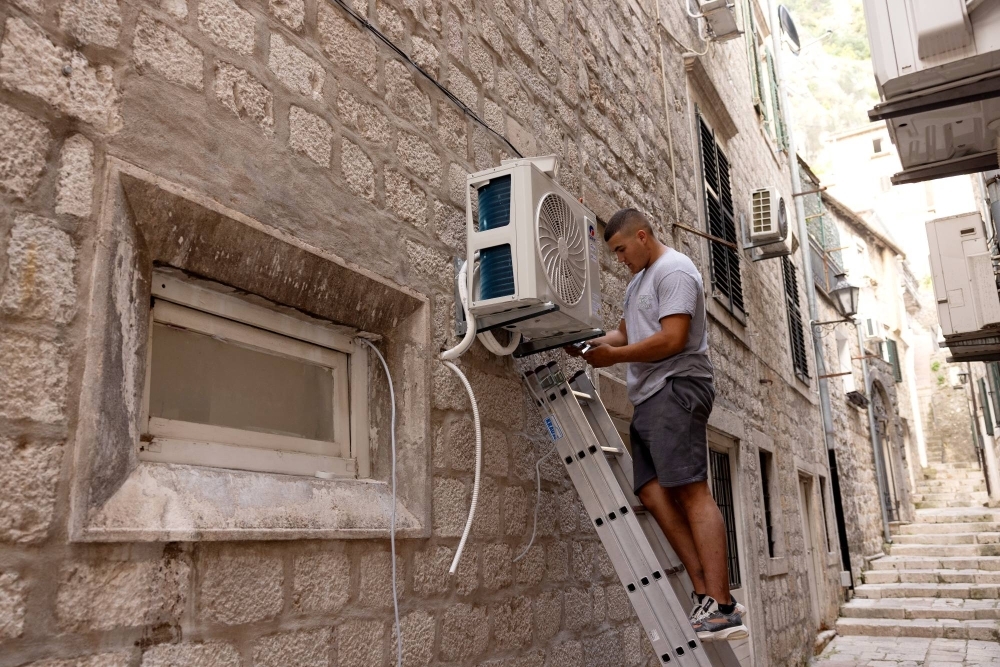- cross-posted to:
- worldnews@lemmy.ml
- climate@slrpnk.net
- cross-posted to:
- worldnews@lemmy.ml
- climate@slrpnk.net
cross-posted from: https://lemmy.ml/post/18013671
The grid needs to be decentralized. More solar on rooftops and neighborhood backup batteries. This would help level out demand.
In other parts of the world this is fairly affordable. In the USA its astronomically higher. I speak from firsthand experience. When installed its wonderful, but is really pricey up-front, and just a small fraction of Americans are both homeowners, and can afford to buy these systems. The Inflation Reduction Act brings the price down from 10x the cost of other nations to just 7x the cost. Its an improvement, but not enough to make these systems widely available to all household budgets.
Rooftop solar panels should be offered for free by either the local government or the power company at this point.
Power companies are beginning to force costs and fees onto solar users because they don’t make any money off of them and are still required to maintain service to the residence. It’s kind of a slap in the face considering how many governments are trying to entice citizens to add it, but C.R.E.A.M. and all that…
local government = revenue from taxes. If the home owners don’t have the money to buy solar, being taxed enough by the local government to pay for solar isn’t going to work either.
power company = nearly all are either co-ops (owned by the consumers) where you’d get the same problem with taxing, or private companies which are for-profit driven industries.
I’m wondering how many residential solar panels our current oil and gas subsidies could fund. Wishful thinking I suppose.
If you’re actually interested in affecting change, you’re going to need to do more than say “someone else should pay for it”. Even more if you’re saying “something I don’t support is getting money, and I want that money to go to the thing I support instead”. Unless you happen to be an authoritarian dictator where your will is law, you have to work within the system if you want change. So far I’m not seeing what you’re posting as a path that will become reality.
If I’ve mistaken your intentions and you just want to have someone else solve the big problem without addressing any of the smaller problems that creates, then I supposed your work is done. Carry on.
Its not just his opinion: its pretty well established that we need to develop this for our future
Its not just his opinion: its pretty well established that we need to develop this for our future
I agree we need to develop it. What is unrealistic is saying “thing X should happen and someone else should pay for it exclusively”. That’s what will keep this a pipe dream instead of turning it into actual reality.
To be fair this is just if you pay professionals to do it. They charge astronomically out the ass for labor for no reason. The actual cost of the equipment is surprisingly little if you buy it yourself, and installing it is very straightforward and easy you do not need to be particularly intelligent or skilled. I’ve done about five different systems at this point, two on RVs and three on houses. One of the houses and one of the RVs was my own and the rest are friends that I have helped set it up.
For example with a goal of about 20k spent This bundle gets you 12Kw of inverter output and 30Kwh of batteries for 11k. Then just grab two Of these solar panel pallets for 28Kw of panels. Or Alternatively go smaller with just one pallet and save a bit. Then ofc you will get the 30% federal tax credit on top of everything.
Ask any installer for a similar sized system and it’s almost certainly going to be 80k+ at minimum. The only part you may definitely want a professional for is if you plan on roof mounting them, have a roofer come help install the framing so you can ensure no leaks. But for ground mount (or if you are familiar with roofing) even that’s not needed.
The actual electrical works is very straight forward. Everything is very clearly labeled, the documentation is very explicit about what goes where. On the solar panel side you’re literally working with DC so you’re literally only dealing with positive and negative. Even on the AC coupling side when you’re talking about an off-grid inverter you’re not back feeding into the grid so it’s very straightforward. Your house grid goes into the input, and your output on the inverter goes to your panel.
The only stuff to watch out for in the NEC is rules about where your secondary panel for the solar output can be placed, has to be a certain distance from the ground, has to have a certain amount of clearance around it on all sides, has to be accessible, stuff like that but it’s all fairly easy to just look up thankfully
Yeah I did an 11.68K system on my house with battery backup for the critical stuff like refrigerator. Cost was 18K for parts, permits, and PE drawings. Me and my wife were able to do all the work except for moving the panels up on the roof. Two friend helped with that task.
Not sure what the price is elsewhere, but I got 6.4 kW solar panels and a 10kW battery backup last year, and the cost was $33k USD. This was in U.S. Midwest (Colorado) and with a local (not National) Solar provider.
I paid cash to avoid the 6% rate loan and additional fees, and I received a $9k tax credit for it this year, bringing the total cost down to $24k. I think this is an expense beyond many Americans, especially since this system could take over a decade to pay for itself, if it does at all.
No point here, just figured I’d point it out so people are aware of the cost. And bear in mind, this is a small system, in a small (just over 1k sq/ft) home.
Just finished installing a 11kw system with 2 Powerwalls in MA and it was closer to $70k. Rebates, tax credit, etc. will help a lot though.
Makes sense, that’s like 80% more solar capacity and you’re probably paying the Tesla markup on the batteries. You’d also need a larger inverter, as 2 powerwalls inline would give 10kW output (5kW each). My battery and inverter are Solaredge, and the inverter is only 7.2kW.
Sounds like the price was relatively in line with mine, just different parts and larger scale.
If you do it yourself it can be so much cheaper, For example with a goal of about 20k spent This bundle gets you 12Kw of inverter output and 30Kwh of batteries for 11k. Then just grab two Of these solar panel pallets for 28Kw of panels. Or Alternatively go smaller with just one pallet and save a bit. Then ofc you will get the 30% federal tax credit on top of everything
Not everybody is going to want to do it themselves I get that, it’s actually very easy and straightforward I posted another comment here up above that goes into more detail but honestly just about anyone could learn to do it it’s not advanced electrical work by any stretch of the imagination.
Not everybody is going to want to do it themselves I get that, it’s actually very easy and straightforward…
Not really. That likely depends entirely on where you live. In my county you’re required to have electrical and construction permits for the work, and the install must be carried out by solar installers with at least one licensed roofing professional and the electrical portion by a licensed electrician. You also can’t connect it back to the grid for net-metering without further inspection by the county once the work is completed. Part of the cost was all the licensing and permitting, as well as submitting the official install plan to the county for approval.
That’s not something I would undertake myself. Not only would I not be able to connect to the grid, but my home would be uninsurable.
Not region specific, but this is relevant: https://www.itekenergy.com/installation/installing-solar-panels-without-a-permit/
Off-grid inverters bypass a LOT of that. And i should have been more clear on no backfeed. I would never recommend backfeed tbh. It comes with insane amounts of red tape, as you’ve noted, the equipment is also much more expensive for grid tie.
Off-grid inverters are basically a backup UPS on steroids. They accept grid as an input but don’t feed back to it. They have far less regulation on their installations. Some places indeed you will still have some but usually you can get away with just having the final install inspected by a master electrician.
That’s fair. For me, I don’t have enough roof space or space for battery to do a fully off-grid system. I would have liked to, but I’ve got mountains to the west and I only get good sun on the southeast facing side of the house, so unless I do a porch expansion and battery capacity to size ratio improves, grid-tied was my best option.
My power company is a not-for-profit co-op and offers 1:1 net-metering, as well as reduced costs for off-peak hours for solar and heat pump users. I’ve managed my energy use to the point I’m at net-zero usage (101.5% production to my usage), but there are low production days where I have to tap the grid and high production days where I produce way more than I draw.
Edit - other considerations as well, e.g. - solar installer guarantees the work for 15 years (panels) and 10 years (battery) and will fix any issues free (if they’re still in business, if not it’s guaranteed by Solaredge given professional installation). And Solaredge tends to not work with individuals. Honestly, I did look into self-installing and IIRC I would have saved maybe $9k or $10k doing a DIY install, but given the tools I would need, knowledge and resources to do it right, time required to do it alone, and the lack of grid access/backfeed… it was very much worth the extra cost to me. And that additional cost was technically refunded to me when I filed taxes.
We absolutely need to address the underlying causes of climate change. However, thats likely not going to be enough for people on the ground.
I just checked my solar panel production and its currently covering all the house electricity consumption (including Air Conditioning), and also pushing back 6kW to the grid. I think systems like this may need to become the norm for all houses with the continued instability of the grid now and in the future.
This. The issue is with the networks and storage. It is quite often the case that enough electricity is produced just in the wrong place and time.
This is becoming an issue in Australia, we have high solar uptake but a lot of systems were installed before batteries were readily available earlier on or without batteries to save outlay. The result is that there is more energy on the grid during the day while nobody is home and the grid highly utilised at night, but there is less people paying utility fees & usage so the grid will soon become underfunded for repairs and expanding infrastructure.
Its not a problem yet but there will be policy and taxing changes in the near future to account for this (similar to fuel exercise tax being shifted from being tacked onto the fuel prices to instead be some tax or licence fee as we shift to electric/green tech vehicles)
We absolutely need to address the underlying causes of climate change.
Guess what happens if the Rs win in November
Oh boy, more tales from a dying planet.
Yes, shit is taking real form now.
I think George Carlin had the best take regarding climat change if I’m not mistaken and it was something along the lines of, “no the planet is not dying we are the planet will be fine after us” and I have to agree have you seen the movies in which humanity dies and the planet it’s just natural taking over everywhere, that what’s going to happend, we will fuck things up untill we die from our own stupidity and then the planet will heal herself!
Except we’ll take countless other species with us (on top of the ones we’ve already wiped out)
We always have done that and due to use who knows how many species are already extinct! Thing is after we ar out nature will come back and other species will rise up from the ashes!
The destruction of the human species is a farce. The destruction to the rest of the ecosphere we’re responsible for is the real tragedy.
They’re both tragedies
My $460 power bill in texas agrees I hate it here but my entire support community is located here :(
Here in California, my annual bill is a little over $6500/year, so $540ish/month. I can only use one company and the PUC is about to approve yet another rate increase again (they’ve never been rejected).
So keep burning that coal.
reading this post during a blackout
Texas?
Ercot lol… goddamn
nope i’m not in the US but the area i live in had rarely blackouts, but i assume 90% humidity and 30°C could be a cause
ah, that’s the rest of the world; texas is suffering from a hurricane and the crumbling texas infrastructure. good luck!
Wake up babe, the world is rapidly falling apart, but I got us some paper straws, so we should be okay…
The plastic straws thing drives me up the wall.
They had to choose the smallest of possible plastic items to replace with the smallest impact (compared to things like plastic plates/cutlery or something). But paper/cardboard straws SUCK. Smoothies/thick shakes/juices/cocktails, its mush before your done or just straight up bends and snaps when you try to stir the drink after a couple minutes of bing in there. Plastic straws disappeared immediately but the lids for coffee cups and soft drinks are only just getting phased out now? Its like they did the absolute least possible and went “look at us saving the environment!”. At least bamboo straws and other biodegradables hold up the whole way through the drink.Indeed, the whole paper straw thing is ridiculous. But let’s not forget that poor sea turtle that they pulled a plastic straw out of its nose. Yeah, that was a random one-off, not very likely to happen again anytime soon. If anything, they need to be more worried about fish, dolphins and turtles getting hung up in lost fishing nets…
Back to the stupid straw thing, someone on that other site that we don’t tend to speak of mentioned a perfect solution. Use a Twizzler candy, they’re hollow and edible once you’re done!
and why not a beef jerky six pack holder for your beer
Well now I want a pack of beef jerky straws…
Is that even a thing yet?.. 🤔
Power grids are failing. Sounds like a great time to add millions of EVs, to the mix.
There are so many problems with that article it isn’t even funny.
Here are a few:
- It references the UK. The US and China are the biggest polluters. Meaning most cars are charged using fossil fuels and coal.
- The article states it is a challenge to convert the DC from the car to the AC if the grid.
- It seems to completely forget that a car has to be charged before it can discharge. The author seems to think thinking can solve it all.
- A car that is used to charge the grid is LOSING the charge it needs to drive, which is the primary purpose of the car.
- No matter how you slice it, some car owners simply can’t use an electric vehicle. People who live in apartments for instance.
The answer isn’t electric cars. The answer is LESS cars.






